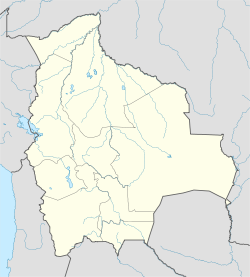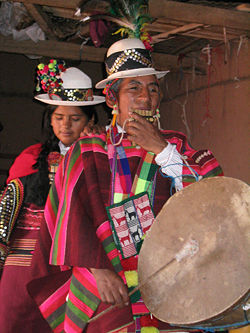- Sucre
-
Sucre
Charcas
La Plata, ChuquisacaPanorama of the Old Town of Sucre. 
FlagNickname(s): The White City, City of the 4 Names Location of Sucre within Bolivia. Coordinates: 19°2′2.04″S 65°15′45.36″W / 19.0339°S 65.2626°WCoordinates: 19°2′2.04″S 65°15′45.36″W / 19.0339°S 65.2626°W Country Bolivia Departament Chuquisaca Province Oropeza Province Founded September 29, 1539 Government – Mayor Verónica Berríos Elevation 2,750 m (9,022 ft) Population (2006) – Total 225,000 Time zone BOT (UTC−4) Area code(s) 4 Website www.sucre.gob.bo/ Official name: Historic City of Sucre Type: Cultural Criteria: iv Designated: 1991 (15th session) Reference #: 566 State Party:  Bolivia
BoliviaRegion: Latin America and the Caribbean Sucre, also known historically as Charcas, La Plata and Chuquisaca (population 247,300 in 2006) is the constitutional capital of Bolivia and the capital of the department of Chuquisaca. Located in the south-central part of the country, Sucre lies at an elevation of 2750m (9,000 ft). This relatively high altitude gives the city a cool temperate climate year-round.
Contents
History
On November 30, 1538, Sucre was founded under the name Ciudad de la Plata de la Nueva Toledo by Pedro Anzures, Marqués de Campo Redondo. In 1538, the Spanish King Philip II established the Audiencia de Charcas in La Plata with authority over an area which covers what is now Paraguay, southeastern Peru, Northern Chile and Argentina, and much of Bolivia. The Audiencia de Charcas was a subdivision of the Viceroyalty of Peru. In 1601, the Recoleta Monastery was founded by the Franciscans and in 1609, an archbishopric was founded in the city. In 1624, St Francis Xavier University of Chuquisaca was founded.
Very much a Spanish city during the colonial era, the narrow streets of the city centre are organised in a grid, reflecting the Andalusian culture that is embodied in the architecture of the city's great houses and numerous convents and churches. Sucre remains the seat of the Roman Catholic Church in Bolivia, and a common sight is members of religious orders dressed in traditional costume. For much of its colonial history, Sucre's temperate climate was preferred by the Spanish royalty and wealthy families involved in silver trade coming from Potosí. Testament to this is the Glorieta Castle. Sucre's University (Universidad Mayor Real & Pontificia de San Francisco Xavier de Chuquisaca) is one of the oldest universities in the new world.
Until the 19th century, La Plata was the judicial, religious and cultural centre of the region. In 1839, after the city became the capital of Bolivia, it was renamed in honour of the revolutionary leader Antonio José de Sucre. Too remote after the economic decline of Potosí and its silver industry, it saw the Bolivian seat of government move to La Paz in 1898. Many[who?] argue Sucre was the epicentre that initiated the independence campaign against Spain in all of Latin America. The first "Grito Libertario" (Shout for Freedom) in any Western Hemisphere Spanish colony of took place in Sucre in 1809. Ironically, Bolivia was the last territory to gain its independence in 1825. In 1991, Sucre became a UNESCO World Heritage Site.
The city attracts thousands of tourists every year due to its well-preserved downtown with buildings from the 18th and 19th centuries. Nestled at the foot of the twin hills of Churuquella and Sika Sika, Sucre is the gateway to numerous small villages that date from the colonial era, the most well-known of which is Tarabuco, home of the colorful "Pujllay" festival held each March. Most of these villagers are members of one of the indigenous ethnicities. Many dress in clothing distinctive to their respective villages.
Government
Sucre is the capital of Chuquisaca department and the constitutional capital of Bolivia, where the Supreme Court is located. The government of the City of Sucre is divided into the executive and legislative branches. The Mayor of Sucre is the head of the city government, elected for a term of five years by general election. The legislative branch consists of The Municipal Council, which elects a President, Vice President and Secretary from a group of eleven members.
The current mayor of Sucre is Verónica Berríos (of the MAS party), who took office on 21 June 2010, and was briefly replaced by Santos Romero in January 2011.[1]
Date Began Date Ended Governor Party Notes Nov 2008 Aydeé Nava PAÍS Nov 2008 30 May 2010 Hugo Loayza MBL Assumed office after Nava was indicted on corruption charges 30 May 2010 18 June 2010 Jaime Barrón Poveda PAÍS Elected in regional election on 4 April 22 June 2010 10 January 2011 Verónica Berríos MAS Designated as interim Mayor by Sucre's Council in Resolution 335/10 after Barrón was indicted on charges of organizing the violence of 24 May 2008[1] 10 January 2011 27 January 2011 Santos Romero MAS Designated as interim Mayor by Sucre's Council in Resolution 03/11[1] 27 July 2011 Verónica Berríos MAS Restored to office when the Guarantees Tribunal of Chuquisaca's Superior Court of Justice annulled Resolution 03/11[1] The current Municipal Council was elected in the regional election of 4 April 2010. The election was by proportional representation with the Pact of Social Integration and the Movement Towards Socialism gaining the largest and second largest shares of the vote.
The council elected in April 2010 and seated in late December 2010 is as follows:
Office Council Member Biography Party President Domingo Martínez Cáceres Agricultural engineer, former Sub-Mayor, previous Council President, docent in the Agronomy Faculty at UMRPSFXCH. Sucre First Vice President Germán Gutiérrez Gantier Lawyer, former Mayor of Sucre, former national Deputy, former member of the Judicial Council, docent Pact of Social Integration Secretary Arminda Corina Herrera Gonzales Teacher, Constituent Assembly member for Chuquisaca and former MAS member New Citizen Alternative Nelson Guzmán Fernández Communicator, law student, leader of Federación Universitaria Local and the University Club. Pact of Social Integration Susy Barrios Quiroz Psychologist, former Sub-Mayor of Districts 2 and 5, President of Feminine Civic Committee of Chuquisaca Pact of Social Integration Norma Rojas Salazar Executive Secretary of Bolivian Red Cross and neighborhood leader Pact of Social Integration Juán Nacer Villagómez Ledezma Public health doctor, former docent, former functionary of the Health Ministry and former chief of the Planning Unit of the Departmental Health Service MAS-IPSP Verónica Berríos chosen as interim Mayor 19 June 2010
Vladimir Paca Lezano alternate serving since June 2010Berrios: Laboratory worker, lawyer, sociology student MAS-IPSP José Santos Romero Campesino leader, former leader of Chaunaca Subcentral of the campesion federation, and member of the Association of Milk Producers of Potolo MAS-IPSP Marlene Rosales Valverde Businesswoman and leader of Fourth Federations of Shopkeepers of Sucre. MAS-IPSP Lourdes Millares Lawyer, former national Deputy for NFR and former head of PODEMOS parliamentary delegation Pact of Social Integration (ran with Sucre First) Sources: "Alcalde electo en Sucre sólo tendrá cuatro concejales". Correo del Sur. 2010-04-06. http://www.cedib.org/index.php?/abril-2010/alcalde-electo-en-sucre-solo-tendra-cuatro-concejales-correo-del-sur-06/04/2010.html. Retrieved 2011-02-03. "Crisis institucional se apodera del flamante gobierno municipal de Sucre". Los Tiempos. 2010-06-02. http://www.lostiempos.com/diario/actualidad/nacional/20100602/crisis-institucional-se-apodera-del-flamante-gobierno-municipal-de_73664_136906.html. Retrieved 2011-02-03. Geography and territorial organization
Sucre is divided into eight, numbered districts: the first five of these are urban districts, while Districts 6, 7, and 8 are rural districts. Each is administered by a Sub-Mayor (Spanish: Subalcalde), appointed by the Mayor of Sucre. The rural districts include numerous rural communities outside the urban area.
Sucre is served by Juana Azurduy de Padilla International Airport, situated 5 km to the Northwest and connected by Avenida Juana Azurduy de Padilla.
The City of Four Names
Each of the well known names represent a specific era of the city's history.
- Charcas was the indigenous name for the place upon which the Spaniards built the colonial city.
- La Plata was the name given to the emerging Hispanic city of privilege and honor.
- The name Chuquisaca was bestowed upon the city during the independence era.
- Sucre honors the great marshal of the Battle of Ayacucho (December 9, 1824), Don Antonio José de Sucre.
Buildings
The House of Freedom (La Casa de la Libertad)
Built in 1621, it is perhaps the most important building of the nation. The republic was founded in this building by Simón Bolívar who wrote the Bolivian Constitution.
The "Salón de la Independencia" houses the Bolivian Declaration of Independence.National Library (La Biblioteca Nacional)
Built on the same year of the foundation of the Republic, it is the first and the most important historical, bibliographical and documentation center of the country. The National Library has documents that date from 15th century.Metropolitan Cathedral (La Catedral Metropolitana)
Built between 1559 to 1712, the cathedral has the "Museo Catedraliceo" which is the first and most important religious museum of the country. The "Pinacoteca" has a vast collection of paintings by Colonial and Republican masters and also by Europeans such as Bitti, Fourchaudt and Van Dyck. The Cathedral contains a vast amount of jewelry made of gold, silver and gemstones.Archbishop's Palace (El Palacio Arzobispal)
Built in 1609, was an important religious and historic institution during colonial times.Churches and Convents
San Felipe Nery
San Francisco
La Recoleta
Santa Teresa
Santa ClaraChurches
Santo Domingo
San Lazaro
San Sebastian
Iglesia de la Merced
San Agustín
Santa Mónica
Santa Barbara
San MiguelChapels
Loreto's Chapel
Virgen de GuadalupeSee also
References
- ^ a b c d "Fallo judicial restituye a Alcaldesa de Sucre". Los Tiempos [byline: Correo del Sur]. 2011-01-28. http://www.lostiempos.com/diario/actualidad/politica/20110128/fallo-judicial-restituye-a-alcaldesa-de-sucre_110589_217524.html. Retrieved 2011-01-30.
External links
World Heritage Sites in Bolivia Jesuit Missions of the Chiquitos · Fuerte de Samaipata · Noel Kempff Mercado National Park · City of Potosí · Historic City of Sucre · Tiwanaku: Spiritual and Political Centre of the Tiwanaku Culture

Capitals of South America  Chuquisaca DepartmentCapital: Sucre
Chuquisaca DepartmentCapital: SucreProvinces Azurduy • Belisario Boeto • Hernando Siles • Jaime Zudáñez • Luis Calvo • Nor Cinti • Oropeza • Sud Cinti • Tomina • Yamparáez
Municipalities and seats Camargo (Camargo) • Camataqui (Camataqui) • Culpina (Culpina) • El Villar (El Villar) • Huacareta (Huacareta) • Huacaya (Huacaya) • Icla (Icla) • Incahuasi (Incahuasi) • Las Carreras (Las Carreras) • Macharetí (Macharetí) • Mojocoya (Mojocoya) • Monteagudo (Monteagudo) • Muyupampa (Villa Vaca Guzmán) • Padilla (Padilla) • Poroma (Poroma) • Presto (Presto) • San Lucas (San Lucas) • Sopachuy (Sopachuy) • Sucre (Sucre) • Tarabuco (Tarabuco) • Tarvita (Tarvita) • Tomina (Tomina) • Villa Alcalá (Villa Alcalá) • Villa Charcas (Villa Charcas) • Villa Serrano (Villa Serrano) • Villa Zudáñez (Zudáñez) • Yotala (Yotala) • Villa Azurduy (Azurduy) • Yamparáez (Yamparáez)Categories:- World Heritage Sites in Bolivia
- Sucre
- Capitals in South America
- Populated places established in 1538
Wikimedia Foundation. 2010.



